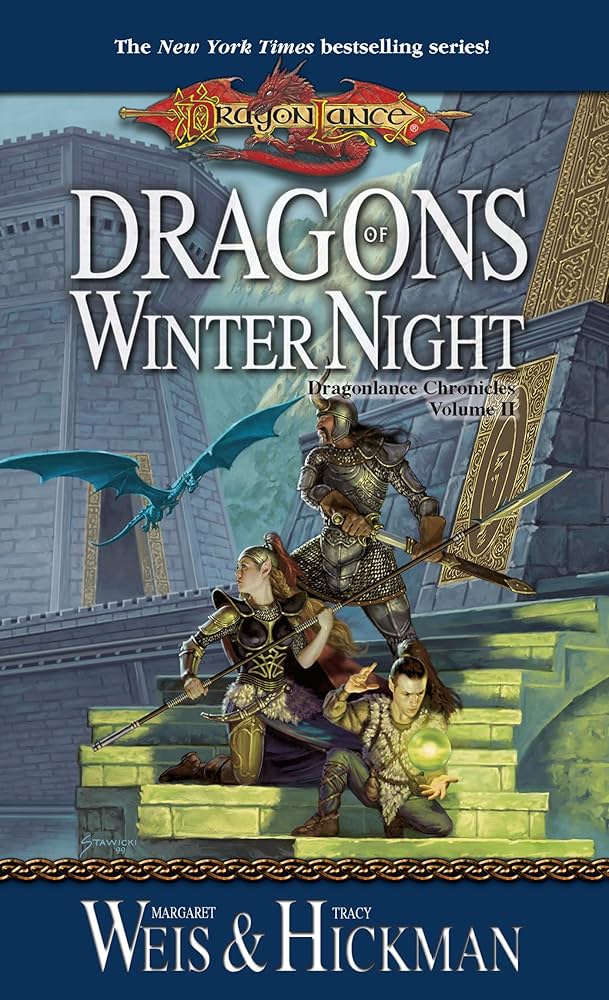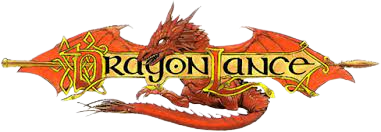Dragons of Winter Night

Table of Contents
ToggleOverview
Dragons of Winter Night is the dark middle chapter of the Chronicles trilogy, where the stakes rise dramatically. The companions, now heroes of the resistance, must navigate military alliances, personal betrayals, political intrigue, and spiritual awakenings as the Dragonarmies of Takhisis push across Ansalon.
This installment adds complexity to the world of Krynn, expanding its religions, races, and politics, while showing how heroism comes at a cost. Themes of sacrifice, loss, and doubt take center stage as dragons and darkness continue to sweep the continent.
Main Characters (Key Focus)
While all the companions return, this book focuses more deeply on:
Tanis Half-Elven – Still the reluctant leader, now caught in a personal and political love triangle (Laurana vs. Kitiara).
Laurana Kanan – Formerly a naive elven princess, she undergoes one of the series’ most powerful character arcs—from privileged noble to battle-hardened leader.
Raistlin Majere – Grows more mysterious, distant, and powerful. His health declines, but his magical strength increases, and the seeds of his future ambitions are sown.
Sturm Brightblade – His honor and lineage take center stage, especially during the political fallout in the Knights of Solamnia.
Kitiara uth Matar – Introduced fully here as a Dragonarmy Highlord, and a deadly blend of charisma, ambition, and cold pragmatism.
Tasslehoff, Flint, Caramon, Goldmoon, Riverwind – Still important, though more often in supporting roles. Tas and Flint’s friendship remains a highlight.
Plot Summary
After Pax Tharkas
Following the events of Dragons of Autumn Twilight, the group has helped free hundreds of slaves from Pax Tharkas and now leads them toward safety in Thorbardin, the dwarven kingdom. There, they are given the legendary Dragonlance—a weapon designed specifically to combat the evil dragons.
This discovery signals that there is hope—but also confirms that a massive war is underway.
The Splintering of the Companions
As winter falls, the companions must split up:
- One group travels to Icewall Glacier, seeking another Dragonlance and more signs from the gods.
- Another journeys to the elven lands of Silvanesti, where they face a haunting dreamscape conjured by a mad elven king and learn of an ancient, dark future.
These journeys are both physical and symbolic—showing how far each character must go to find their role in the war, and themselves.
Laurana’s Transformation
Laurana follows Tanis and the others to Tarsis, only to be abandoned when Tanis leaves with Kitiara. Left behind, Laurana steps up as a tactician and leader, ultimately defending the city of the Whitestone Council and leading Solamnic forces with bravery and intelligence.
Her arc from spoiled noble to capable commander is one of the most dramatic in the entire series.
Knights of Solamnia & Sturm’s Legacy
The companions travel to Sancrist Isle, seeking an alliance with the Knights of Solamnia. There, political strife prevents immediate unity. Sturm Brightblade is accused of falsely claiming his knighthood, and the honor of the order is in question.
In the climactic battle at the High Clerist’s Tower, Sturm sacrifices himself to delay the Dragonarmy and allow victory. His death restores faith in the knighthood and solidifies him as a true hero—posthumously accepted as a Knight of the Rose.
The Whitestone Council
The council of the free peoples of Krynn convenes at Whitestone, debating how to unify against the Dragonarmies. There’s infighting, distrust, and doubts—but eventually, the Dragonlances are accepted, and dragons of good (metallic dragons) finally return to join the fight.
Tanis and Kitiara
Tanis is torn between his love for Laurana and his complicated passion for Kitiara, who is now revealed as a Highlord of the Dragonarmies. Their reunion is intense, passionate, and dangerous. Tanis plays a risky game of deception, trying to learn her plans while navigating their past.
Kitiara reveals that she controls the blue dragon Skie, and has taken Laurana prisoner—setting the stage for the next book’s rescue mission and final confrontations.
Major Themes
- Leadership and Growth – Laurana and Sturm emerge as powerful symbols of duty and sacrifice.
- Honor vs. Pragmatism – Sturm’s idealism contrasts with Tanis’s inner conflict and Kitiara’s ruthless ambition.
- Loss and Legacy – The death of Sturm and the fracturing of the companions underscores the cost of heroism.
- Faith and Destiny – The return of the gods (good and evil) and the forging of the Dragonlances signal a divine reshaping of the world.
- Women and Power – Laurana and Kitiara serve as mirrored archetypes—one fighting for unity and justice, the other for dominance and control.
Tone & Style
Dragons of Winter Night is darker, more introspective, and more mature than its predecessor:
- Political and strategic dilemmas take precedence over dungeon crawls.
- Battles are epic and costly (the High Clerist’s Tower is a high point).
- There’s a stronger sense of moral ambiguity—especially with Tanis, Raistlin, and Kitiara.
This is the book where the Dragonlance saga goes from fun adventure to emotional epic.
Reception
Dragons of Winter Night is often considered the best written and most emotional of the Chronicles trilogy. It’s praised for:
- Sturm’s heroic arc and sacrifice
- Laurana’s remarkable character development
- The escalation in tone, stakes, and narrative complexity
- Deepening the relationships between companions—and revealing their flaws
Some readers are frustrated by Tanis’s indecision, but this tension is deliberate, and sets up the final resolution in Spring Dawning.
Final Thoughts
Dragons of Winter Night is the heart and soul of the Chronicles trilogy. It is a novel of turning points, sacrifices, and rising stakes. Where the first book introduced a world on the brink, this book shows it tipping into war—and how individual choices can shape the future of Krynn.
Recommended for:
- Fans who love deep character arcs and emotional payoff
- Readers who want more worldbuilding and military fantasy
- Those curious about Krynn’s fractured alliances and philosophical tensions
